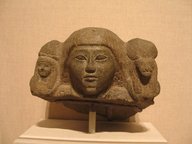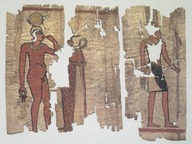Upper Portion of a Striding Statue of a Priest
To the right of the central figure of a priest is the standard of a human-headed god wearing a crown with horns and double plumes, perhaps Ptah-Sokar-Osiris. To the left is the standard of the lion-headed goddess Sakhmet, who sports a solar disk. These standards are indications of privilege representing the king's essential life force, known as his ka. They enabled the bearer to hear prayers and to forward them to the gods. Such standard-bearing sculptures were popular in Dynasty XIX, and this fragment can be dated to that time by the type of wig the priest wears and by his downward-slanting, almond-shaped eyes. Most comparable sculptures, however, bear only one standard, usually the ram-headed god Amun.
- Medium: Stone
- Place Made: Egypt
- Dates: ca. 1295-1185 B.C.E.
- Dynasty: XIX Dynasty
- Period: New Kingdom
- Dimensions: 5 1/2 x 7 5/16 x 4 1/8 in. (14 x 18.5 x 10.5 cm) (show scale)
- Collections:Egyptian, Classical, Ancient Near Eastern Art
- Museum Location:
 This item is on view in Egypt Reborn: Art for Eternity, 19th Dynasty to Roman Period, Martha A. and Robert S. Rubin Gallery, 3rd Floor
This item is on view in Egypt Reborn: Art for Eternity, 19th Dynasty to Roman Period, Martha A. and Robert S. Rubin Gallery, 3rd Floor - Exhibitions:
- Accession Number: 71.37.1
- Credit Line: Charles Edwin Wilbour Fund
- Rights Statement: Creative Commons-BY
- Caption: Upper Portion of a Striding Statue of a Priest, ca. 1295-1185 B.C.E. Stone, 5 1/2 x 7 5/16 x 4 1/8 in. (14 x 18.5 x 10.5 cm). Brooklyn Museum,
brooklynmuseum.org
























































